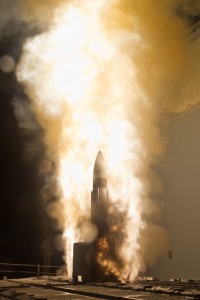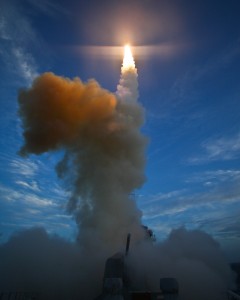2013-05-03 by Richard Weitz
The Navy’s Aegis-SM3 ballistic missile defense (BMD) system has become the main U.S. shield against missile attacks.
It encompasses the Aegis Weapon System, the Standard Missile, and the Navy and Joint Forces Command, Control and Communication systems. In terms of regional defense, Aegis BMD can defeat short-to intermediate-range, unitary and separating, midcourse-phase ballistic missile threats as well as short-range ballistic missiles in the terminal phase.
The SM-3 consists of a kill vehicle attached to a three-stage booster. It intercepts missiles, warheads, and other targets above the atmosphere in their midcourse phase of flight using a “hit-to-kill” collision in which the target is destroyed through the kinetic energy released when the Exo-atmospheric Kill Vehicle (EKV) collides with it. Unlike the troubled Ground-based Midcourse Defense (GMD), the Aegis BMD system can be maneuvered and reconfigured more easily to respond to changes in the threat environment.
The Aegis radar’s role in missile defense has evolved as its capabilities have improved.
The U.S. Navy began the development of the Aegis combat system more than thirty years ago by integrating advanced radar and signals capabilities with a variety of guided missiles deployed on cruisers and destroyers in order to defend aircraft carriers and their battle groups.
In the initial fielding of the BMDS in 2004, Aegis BMD’s role was that of a forward sensor. Aegis BMD ships were forward deployed to extend the battle space, provide early warning of an ICBM launch, and transmit track data to the Ground-based Missile Defense command center. In 2005, Aegis BMD’s role evolved to include an engagement capability. Aegis BMD ships, armed with the SM-3 Block IA, proved capable of intercepting short- to intermediate-range ballistic missiles in the midcourse phase of flight. The Aegis BMD engagement capabilities expanded to include the terminal capability in 2006. The Aegis BMD 3.6.1 configuration (midcourse and terminal engagement capabilities) is presently deployed throughout the Aegis BMD Fleet.

The upgraded BMD 4.0.1 improves target discrimination, enhances target tracking, and allows for longer-range engagements. It offers exo-atmospheric engagement capability against short-, medium-, and some intermediate-range ballistic missiles using the SM-3 Block IA missile and can also provide better support for later SM-3 interceptor versions. These Aegis radars generate tracking data to cue other missile defense sensors and provide the fire control data to GBIs located in Alaska and California. They also cue other BMD systems including THAAD, PAC-3, and other Navy BMD ships.
There are now more than two dozen Aegis BMD combatants in the U.S. Navy, mostly destroyers but also some cruisers. About twice as many of these ships are assigned to the U.S. Pacific Fleet than with the Atlantic Fleet. In response to the increasing demand for Aegis BMD capability from the Combatant Commanders, the MDA and Navy are working together to raise the number of Aegis BMD capable ships. Such efforts consist of upgrading Aegis destroyers to the BMD capability, incorporating Aegis BMD into the Aegis Modernization Program and new construction of Aegis BMD destroyers.
Unfortunately, the sequester process and other reductions in the U.S. defense budget are already leading to curtailment of shipbuilding plans and premature retirements of existing ships, including of Ticonderoga-class cruisers that could contribute directly to missile defense.
By 2018, there should still be some 30 BMD-capable Aegis ships, using all four versions of the Aegis system.
Aegis BMD also provides Sea-Based Terminal defense capability using modified SM-2 Block IV missiles to engage short-range ballistic missiles in the terminal phase. The Standard Missile-2 Block IV (SM-2 Block IV) is designed to intercept shorter-range ballistic missiles inside the atmosphere during their terminal phase of flight. It is equipped with a blast fragmentation warhead. The SM-2 Block IV will be replaced by a BMD version of the new SM-6 interceptor.
The MDA and Navy plans still call for fielding increasingly capable versions of the Standard Missile-3 in coming years.
The current version, the SM-3 Block IA, is the first widely operational U.S. mid-course ballistic missile defense interceptor.
It is now being complemented by the more capable SM-3 Block IB, which can better discriminate and target the warhead despite adversary debris and countermeasures.
It boasts an improved two-color infrared seeker to enhance discrimination of the target, advanced signal processor to take advantage of upgraded Aegis Weapons Systems capabilities, and a throtteable divert and altitude control system that employs short precise propulsion bursts to adjust course as it approaches the target. Additional improvements were added after a failed test in September 2011, which led the Pentagon to extend the development period for the new interceptor.
In February 2013, the Navy intercepted a medium-range ballistic missile using an already operational SM-Block IA interceptor and trafficking data from a remote Raytheon senor payload on the Space Tracking and Surveillance System-Demonstrator (STSS-D) satellites. The interceptor test confirmed that, even as the United States develops and deploys more advanced versions of the SM-3, the existing systems can still play a key role in U.S. and allied missile defenses.
It also demonstrated how using the STSS-D satellites can allow the Navy to expand its battlefield sensor capabilities beyond those organic to a ship’s radar. The BMD ships can detect the path of a missile from greater distances and use the radar to refine its tracking and interception calculations. The satellite sensors also give the Navy greater flexibility in coordinating its BMD ship and battle plans. Since the SM-3 block 1A and SM-3 block 1B missiles are similar in design, the SM-3 1B should also be able to draw on the STSS-D data.
In contrast to the Block IA and 1B versions, which have a 21-inch-diameter booster stage at the bottom but are 13.5 inches in diameter along the remainder of their lengths, the SM-3 Block IIA version will have a 21-inch diameter along its entire length. The increase in diameter to a uniform 21 inches will provide room for larger rocket motors and more rocket fuel, permitting the Block IIA version to achieve a greater maximum velocity, a longer flight time, and a greater distance than that of the SM-3 Block IA and IB versions.

It could also carry a larger-diameter kinetic warhead and cover a larger geographic area. The requirements for developing the SM-3 Block IIA include developing a new propulsion system with a much greater thrust, a new throtteable divert and attitude control system, a more capable seeker, and a new solid fuel.
Recent increases in funding and the R&D partnership with Japan have helped overcome these challenges.
The United States and Japan have cooperated in developing certain technologies for the Block IIA version, with Japan funding a significant share of the effort and leading development of the Block IIA’s second and third stage rocket motors and nosecone.
Despite development delays, the initial SM-3 Block IIA flight test is scheduled for 2015, with a transition for full production around 2018.
Besides its expected deployment on U.S. and Japanese warships, the United States plans to place some of the Block IIA ashore on Poland and perhaps elsewhere. It is expected that an Aegis Ashore battery will strongly resemble the top half of an Aegis warship.
The Obama administration recently cancelled plans to develop a SM-3 Block IIB.
The intent was to deploy the interceptor initially in Europe to provide early intercept capability against long-range ballistic missile threats from Iran. The requirements for the SM-3 Block IIB were always in flux, but the general idea was to have a larger missile with a lighter kill vehicle, more flexible propulsion (perhaps using liquid fuel), and upgraded fire control software. It was to be integrated into the Aegis Weapon System, with the Aegis BMD 5.1 Fire Control and the MK 41 Vertical Launching System, as part of the Aegis Ashore capability.
Although described as a SM-3 variant, the Block IIB would have required a radical departure from the SM-3 evolutionary path.
In recent years, the Government Accountability Office (GAO), the National Academy of Sciences, and other expert bodies had criticized the SM-3 IIB plan as unrealistic due to the major technological challenges in achieving an early intercept of an Iranian ICBM. Coming technological developments might allow the development of a system like the envisaged Block IIB, but it would really be an upgraded version of the GBI.
A more promising route to achieving the desired capacity could be to continue to build on the proven SM-3 model more directly.
The Aegis BMD ships already have a limited role in defending the U.S. homeland from ballistic missiles. Traditionally the SM-3 has been considered too slow to intercept an ICBM, but the Aegis ships can detect and track all incoming ballistic missiles. Their tracking can then be shared with the BDMS to cue other sensors and provide fire control data to the Ground-based Midcourse Defense interceptors and other “shooters.”
However, the Aegis/SM-3 combination can play a greater role in homeland defense to help compensate for the cancellation of the SM-3 IIB and the continued weaknesses with the GBI.
In particular, the SM-IB and SM-IIA could be paired with a new X-band radar located in the northeast United States to fill a gap in U.S. defenses.
Editor’s Note: The further development of the US-Japanese relationship in the Pacific is a keystone for 21st century deterrence. In our forthcoming book Rebuilding the US Military: Shaping a 21st Century Pacific Strategy, the centrality of this relationship in the deterrence of China is highlighted.
Japanese engagement in key US-led programs, such as the F-35, Aegis and SM-3 are central parts of a 21st century approach. The book will be published by Praeger publishers.
Japan tests the SM-3 in a 2010 testing event.

